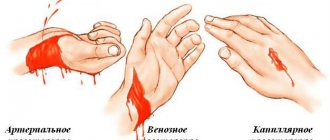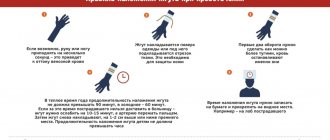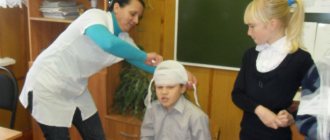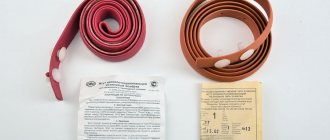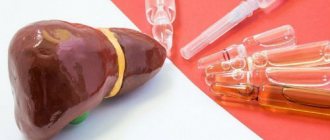Causes of bleeding
The following factors can cause bleeding:
- mechanical damage to blood vessels;
- neoplasm or inflammatory process in the walls of blood vessels;
- deterioration of the integrity of blood vessels due to infection, lack of vitamins or poisoning of the body.
Remember that timely assistance with bleeding can save the victim’s life!
1 Help with bleeding. Types of bleeding
2 Help with bleeding. Types of bleeding
3 Help with bleeding. Types of bleeding
STRETCH
Sprain is damage to soft tissues (ligaments, muscles, tendons, nerves) under the influence of a force that does not violate their integrity. Most often, sprains of the ligamentous apparatus of the joints occur during incorrect, sudden and sharp movements that go beyond the normal range of motion of a given joint (when turning the foot, lateral turns of the leg with a fixed foot, etc.). In more severe cases, a tear or complete rupture of the ligaments and joint capsule may occur.
SIGNS: the appearance of sudden severe pain, swelling, impaired movement in the joints, hemorrhage into the soft tissues. When you feel the stretched area, pain appears.
FIRST AID involves providing rest to the victim, tightly bandaging the damaged joint, ensuring its mobility and reducing hemorrhage. Then you need to consult a traumatologist.
Types of bleeding
The type of bleeding depends on which vessel is damaged, in which part of the body it is localized, and the intensity of blood loss.
Classification according to the type of damage to blood vessels:
- capillary bleeding;
- venous;
- internal (parenchymal);
- arterial;
- mixed bleeding.
Classification according to the cause of bleeding:
- abnormal bleeding;
- traumatic.
Classification according to the location of blood loss:
- external;
- internal.
Classification by volume of blood loss:
On average, about 5 liters of blood circulates in the body of an adult. Depending on the volume of fluid spilled, doctors distinguish the following degrees of blood loss:
- mild degree (less than 0.5 liters);
- medium (less than 1 liter);
- heavy (about 1.5 liters);
- massive (about 2.5 liters);
- lethal (about 3 liters), i.e. more than half of the total blood volume;
- absolutely lethal (more than 3.5 liters), i.e. above 60%.
First aid for bleeding is a system of therapeutic and preventive measures that must be taken in case of damage to blood vessels (arteries, capillaries and veins) until qualified medical assistance becomes available. Each type of bleeding has its own characteristics in providing assistance.
ARTIFICIAL RESPIRATION
ARTIFICIAL RESPIRATION is an emergency first aid measure for drowning, suffocation, electric shock, heat and sunstroke. This is carried out until the victim’s breathing is restored.
THE MECHANISM OF ARTIFICIAL RESPIRATION is as follows:
- place the victim on a horizontal surface;
- clear the victim’s mouth and throat of saliva, mucus, soil and other foreign objects; if the jaws are tightly clenched, move them apart;
- tilt the victim’s head back, placing one hand on the forehead and the other on the back of the head;
- take a deep breath, bend over to the victim, seal the area of his mouth with your lips and exhale. The exhalation should last about 1 second and help lift the victim’s chest. In this case, the victim’s nostrils should be closed and his mouth covered with gauze or a handkerchief for reasons of hygiene;
— frequency of artificial respiration – 16-18 times per minute;
- periodically empty the victim’s stomach of air by pressing on the epigastric region.
General rules of first aid for bleeding
If the victim has lost a significant amount of blood, try to lay him down and elevate his legs.
Do not touch the wound with your hands or remove glass shards from it.
If sand and rust get into the wound, do not wash the damage, as this will increase the bleeding.
If the wound becomes dirty, you need to carefully remove the dirt in the direction from the wound, then treat the cleaned edges with an antiseptic.
When treating the edges of a wound with an iodine solution, do not allow the antiseptic to get inside the wound.
Depending on the type of blood loss, try to stop the bleeding using a tourniquet, twisting, or squeezing the damaged vessel.
First aid for capillary bleeding
Bleeding from the capillaries is not accompanied by large blood loss and stops relatively quickly. A sign of capillary damage is the appearance of a gentle stream of blood on the wound.
First aid for this bleeding includes treating the edges of the wound with an alcohol antiseptic (iodine), on which an aseptic gauze bandage is applied. Please note that the bandage is not tight. Usually, with capillary bleeding, there is no need to go to the hospital, with the exception of situations where the damage is extensive.
1 First aid for bleeding
2 First aid for bleeding
3 First aid for bleeding
First aid for venous bleeding
A sign of venous bleeding is rapidly flowing dark blood. Its flow is uniform, without gushing or pulsating.
With venous bleeding, blood clots may appear; they cannot be removed, since in this case blood loss may increase.
To stop bleeding, apply a pressure aseptic bandage to the wound. If blood loss continues, it is necessary to apply a tourniquet below the damaged area. To reduce injury to soft tissues and skin, a soft pad is placed on them (under the tourniquet). It is necessary to make a note indicating the time of application of the tourniquet. The maximum time for wearing a tourniquet is 2 hours in warm weather and 1 hour at sub-zero temperatures. The tourniquet cannot be held longer than this time, otherwise the bloodless tissue will begin to die. If you don’t have a tourniquet, you can make twists from available materials: a bandage, a belt, a towel, a piece of fabric using a handle and a short stick. The time frame for the spins is the same. Try not to use any hemostatic drugs without a doctor's prescription.
First aid for arterial bleeding
Arterial bleeding is one of the most dangerous. The main sign of arterial damage is bright scarlet blood flowing out in a pulsating stream at high speed. If large arteries are damaged, the blood begins to flow intermittently, like a fountain.
First aid for this bleeding is to apply a hemostatic tourniquet above the level of the wound. You can also use a twist. Time restrictions are the same.
If there is no tourniquet or twist, you can stop the bleeding by pressing the artery above the damaged area with your finger, i.e. at the pulsation point.
In case of bleeding from the brachial, ulnar, femoral or popliteal artery, you can fix the arm or leg as bent as possible in an elevated position.
FAINTING
Fainting is a sudden short-term loss of consciousness, accompanied by weakening of the heart and breathing. It occurs with rapidly developing anemia of the brain and lasts from a few seconds to 5-10 minutes or more.
SIGNS. Fainting is expressed in a sudden onset of lightheadedness, dizziness, weakness and loss of consciousness.
Fainting is accompanied by paleness and coldness of the skin. Breathing is slow, shallow, weak and rare pulse (up to 40-50 beats per minute).
FIRST AID. First of all, it is necessary to lay the victim on his back so that his head is slightly lowered and his legs are raised. To make breathing easier, free your neck and chest from constricting clothing. Cover the victim warmly and place a heating pad at his feet. Rub the patient's temples with ammonia and bring a cotton swab soaked in ammonia to his nose, and sprinkle his face with cold water. In case of prolonged fainting, artificial respiration is indicated. After regaining consciousness, give him hot coffee.
DISLOCATION
Dislocation is a displacement of the articular ends of bones, partially or completely disrupting their mutual contact.
SIGNS:
the appearance of intense pain in the affected joint;
dysfunction of the limb, manifested in the inability to perform active movements;
forced position of the limb and deformation of the joint shape;
displacement of the articular head with desolation of the articular capsule and springy fixation of the limb in its abnormal position.
Traumatic joint dislocations require immediate first aid. Timely reduction of a dislocation, with proper subsequent treatment, will lead to complete restoration of the impaired limb function.
FIRST AID should consist, as a rule, of fixing the injured limb, administering an anesthetic and sending the victim to a medical facility. Fixation of the limb is carried out with a bandage or hanging it on a scarf. In case of dislocation of the joints of the lower limb, the victim should be taken to a medical facility in a supine position (on a stretcher), with pillows placed under the limb, its fixation, and the victim given an anesthetic. When providing first aid in unclear cases, when it is not possible to distinguish a dislocation from a fracture, the victim should be treated as if he had an obvious bone fracture
CARBON MOXIDE POISONING
CARBON MOXIDE POISONING occurs when it is inhaled and is classified as acute poisoning. Carbon monoxide is formed during combustion and under industrial conditions. It is found in blast furnace, furnace, mine, tunnel, and lighting gases. In the chemical industry, it is formed during technical processes in which this chemical compound serves as the starting material for the synthesis of acetone, phosgene, methyl alcohol, methane, etc.
The damaging effect of carbon monoxide is based on the reaction of the compound with hemoglobin (a chemical compound in the blood, consisting of protein and iron, which supplies tissue with oxygen), resulting in the formation of carboxyhemoglobin, which is unable to transport oxygen to tissues, resulting in hypoxia (oxygen starvation of tissues). This explains the earliest and most pronounced changes in the central nervous system, which is especially sensitive to lack of oxygen.
SIGNS: headache, dizziness, nausea, vomiting, stunned state, severe muscle weakness, blackout, loss of consciousness, coma. When exposed to high concentrations of carbon monoxide, severe poisoning is observed, which is characterized by loss of consciousness, a prolonged coma, leading in especially severe cases to death. In this case, dilation of the pupils with a sluggish reaction to light, an attack of convulsions, sharp tension (rigidity) of the muscles, rapid shallow breathing, and rapid heartbeat are observed. Death occurs when breathing and cardiac activity stop.
FIRST AID. Necessary:
- take the victim to fresh air;
- free your neck and chest from restrictive clothing;
- bring ammonia to your nose;
— if possible, inhale oxygen;
— if necessary, perform artificial respiration and chest compressions;
- urgently transport to a medical facility.
